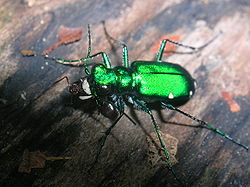Tiger beetle
| Tiger beetle | |
|---|---|

| |
| Cicindela sexguttata | |
| Scientific classification | |
| Kingdom: | |
| Phylum: | |
| Class: | |
| Order: | |
| Suborder: | |
| Family: | |
| Subfamily: | Cicindelinae Latreille, 1802
|
| Tribes | |
|
Cicindelini | |

The tiger beetles are a large group of beetles known for their predatory habits.
Taxonomically, the beetles were traditionally classified as the family Cicindelidae but most authorities now treat them as the subfamily Cicindelinae of the Carabidae (ground beetles). The most recent classifications, however, have relegated them to a subgroup within the subfamily Carabinae, though this is not yet universally accepted; accordingly, there is no consensus classification for this group, at any level from family down to subspecies, and it can be exceedingly difficult to decipher the taxonomic literature surrounding this group. There are about 2,100 species known, with numbers ranging much higher or lower depending on the authority consulted.
Tiger beetles often have large bulging eyes, long, slender legs and large curved mandibles. All are predatory, both as adults and as larvae. The genus Cicindela has a cosmopolitan distribution. Other well-known genera include Megacephala, Omus, Amblycheila and Manticora. While members of the genus Cicindela are usually diurnal and may be out on the hottest days, Megacephala, Omus, Amblycheila and Manticora are all nocturnal. Both Cicindela and Megacephala are often brightly colored, while the other genera mentioned are usually uniform black in color.
Tiger beetles in the genus Manticora are the largest in size of the subfamily. These live primarily in the deserts of South Africa.

The larvae of tiger beetles live in cylindrical burrows as much as a meter deep. They are large-headed, hump-backed grubs that flip backwards to capture prey insects that wander over the ground. The fast-moving adults run down their prey. Some tiger beetles can run at a speed of 5 mph. For its size it has been suggested that they are the fastest running land animals. Some tiger beetles in the tropics are arboreal, but most run on the surface of the ground. They live along sea and lake shores, on sand dunes, around playa lakebeds and on clay banks or woodland paths.
Tiger beetles have been considered as good indicator species and have been used in ecological studies on biodiversity.
Genera
- Amblycheila Say, 1830
- Cicindela Linnaeus, 1758
- Megacephala Latreille, 1802
- Omus Eschscholtz, 1829
Bibliography
- Tiger Beetles of Alberta: Killers on the Clay, Stalkers on the Sand by John Acorn. University of Alberta Press, 2001.
- Tiger Beetles: The Evolution, Ecology, and Diversity of the Cicindelids by David L. Pearson and Alfried P. Vogler. Cornell University Press, 2001.
- A Field Guide to the Tiger Beetles of the United States and Canada by David L. Pearson, C. Barry Knisley and Charles J. Kazilek. Oxford University Press, 2005.
- http://homepage3.nifty.com/trechinae/cicinw.htm (Japanese)
